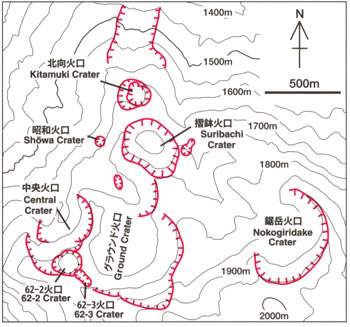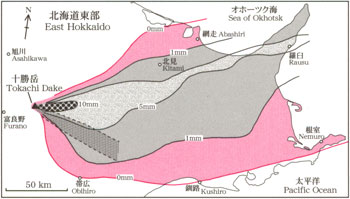Tokachidake Volcano
1: Introduction / 2: Overview of the Tokachidake Volcano Group
3: Eruptive history of the Tokachidake Volcano Group
4: Eruptions in historical times
5: Petrological features of erupted rocks - 6: Sulfur deposit and hot springs
7: Observation of volcanic activities - 8: Points to be noted for mitigation of volcanic disaster
Acknowledgements / References
![]() PREV
PREV ![]() NEXT
NEXT
4: Eruptions in historical times
After 19th century when written records became available, eruptions occurred at the Central and 62 craters, including magma eruptions in 1926, 1962, and 1988-89. Those were all explosive eruptions with ejecta of basaltic andesite. Total volume of the ejecta during the historical period is estimated to be 0.006 km3 DRE. The eruption record is shown in Table 1. Detailed descriptions of those eruptions are summarized in Tada & Tsuya ( 1927 ), Katsui et al. ( 1963b ), Ishikawa et al. ( 1971 ), and Katsui et al. ( 1990 ).
4.1 Eruptions in the 19th century
It is suspected that there were eruptive activities in 1857 and 1887. While Mr. Takeshiro Matsuura was engaged in exploration of the western foot of the Tokachidake volcano group in 1857 ( 4th year of the Ansei era of the Edo period ), he recorded the following in his " Ishikari Diary " : On the flank halfway up the mountain fire and high rising black smoke were visible. Also a man who lived in Naka-Furano Town in the Ansei era recalled that three people met tragic deaths from mudflow ( some say that it was due to flooding ) after the 1926 eruption ( Assistance Society for Sufferers of Tokachidake Eruption, 1929 ). Obinata ( 1891) reported after engaging in his survey of sulfur deposit in 1887 that " it was said that several eruptions occurred every year in recent years and were visible at a distance from the riverbank of the Ishikari River. Ooccasional ash falls had reached even the township of Chubetsu " . From the context of his report, this passage must be a description of hearsay of eruptions. However, ejected materials corresponding to those 1857 and 1887 eruptions have not been identified so far.
4.2 1926-28 Eruption
A series of eruptions of 1926-28 commenced on 5 April 1926 as a small eruption. On 24 May, a month and half later, the eruption culminated just after midday ( 12:11 ) and 4 hours later in the evening ( 16:17 ). The activity had quietened for a while after the culminated eruption but resumed three and half months later on 8 September with the eruption column reaching 4,600 m high. Small eruptions continued intermittently for another 2 years until December 1928.
On 24 May 1926 at the culmination of the eruptions, pyroclastic fall occurred accompanied with the collapse of the Central Cone resulting in debris avalanche. Further, a mud flow went down along the Biei and Furano rivers reaching Kami-Furano Town 25 km away in 25 minutes from the commencement of the eruption. There were 144 deaths and missing for 24 May eruption. 2 deaths and/or missing for 8 September eruption.
Distribution of the 1926 ejecta confirmed just after the eruption is shown in ![]() Fig.4. The amounts of materials are estimated to be: pyroclastic fall deposits 1.3 ×104 m3, and cone collapse 2×106 to 4×106 m3. As currently visible materials consist of deposits from pyroclastic fall, debris avalanche, mudflow, and hydrothermal surge ( Uesawa, 2008 ), it is clear that hydrothermal activity was accompanied in addition to the collapse of the cone. In this map the debris avalanche deposit is shown as 1926 Debris Avalanche Deposits ( Cm ). Pyroclatic fall deposits are exposed on the wall of the crater of the Central Cone with the thickness less than 100 cm, and the mudflow deposits locally distributed along the Biei and Furano rivers with thickness about several centimeters. In the map the mudflow deposits are not shown because the distributions of those are too restricted.
Fig.4. The amounts of materials are estimated to be: pyroclastic fall deposits 1.3 ×104 m3, and cone collapse 2×106 to 4×106 m3. As currently visible materials consist of deposits from pyroclastic fall, debris avalanche, mudflow, and hydrothermal surge ( Uesawa, 2008 ), it is clear that hydrothermal activity was accompanied in addition to the collapse of the cone. In this map the debris avalanche deposit is shown as 1926 Debris Avalanche Deposits ( Cm ). Pyroclatic fall deposits are exposed on the wall of the crater of the Central Cone with the thickness less than 100 cm, and the mudflow deposits locally distributed along the Biei and Furano rivers with thickness about several centimeters. In the map the mudflow deposits are not shown because the distributions of those are too restricted.
4.3 1962 Eruption
The 1962 eruption occurred at the newly created the 62 crater on the western edge of the Ground crater. The eruption started from just after 22:00 on 22 June, and after brief break of four and half hours, it resumed and culminated in the early morning to noon on 23 June. The ejecta are pyroclastic fall deposits. The eruptive column reached about 12,000 m high and ash fall covered the whole of eastern Hokkaido ( ![]() Fig. 5 ), even the south offshore area of Urup Island 650 km away. Small-scale eruptions continued until the end of July. The volume of ejecta was estimated to be 9.7×102 m3 for the first eruption on 22 June and the 7×107 m3 for the second eruption from the early morning to noon on 23 June.
Fig. 5 ), even the south offshore area of Urup Island 650 km away. Small-scale eruptions continued until the end of July. The volume of ejecta was estimated to be 9.7×102 m3 for the first eruption on 22 June and the 7×107 m3 for the second eruption from the early morning to noon on 23 June.
Pyroclastic Cone ( 62 ) was formed around the crater in 1962 eruption and scoria fall deposits ( Tk-8 ) are distributed in ESE direction of the crater. Five craters called the 62-0, 62-1, 62-2, 62-3 and 62-4 craters were created in this eruption, but only the 62-2 and 62-3 craters are survived with the rest buried under later deposits ( ![]() Fig. 2 ).
Fig. 2 ).
4.4 1988-89 Eruption
The 1988-89 eruption occurred at the 62-2 crater. A phreatic eruption began on 16 December 1988, and by a phreatomagmatic eruption on 19 December ash falls reached Abashiri City of the Okhotsk coast. On 24 December a small-scale eruption accompanied with pyroclastic flow and pyroclastic surge was observed. From January to February next year eruptions related to magmatic activities were frequent. The eruption continued for about three months to 5 March 1989. Ash falls during this period are mostly distributed in ENE to SE directions and even the largest ash fall ( 19 December ) was small-scale at 1.2×105 m3. Total volume of the ejecta in 1988-89 is estimated to be 6 to 7×105 m3.
Volcanic bombs ejected on 8 February 1989 are as large as 20 m in diameter and scattered on the eastside of the 62-2 crater. In this map the area where the bombs over several meters have fallen is shown.


